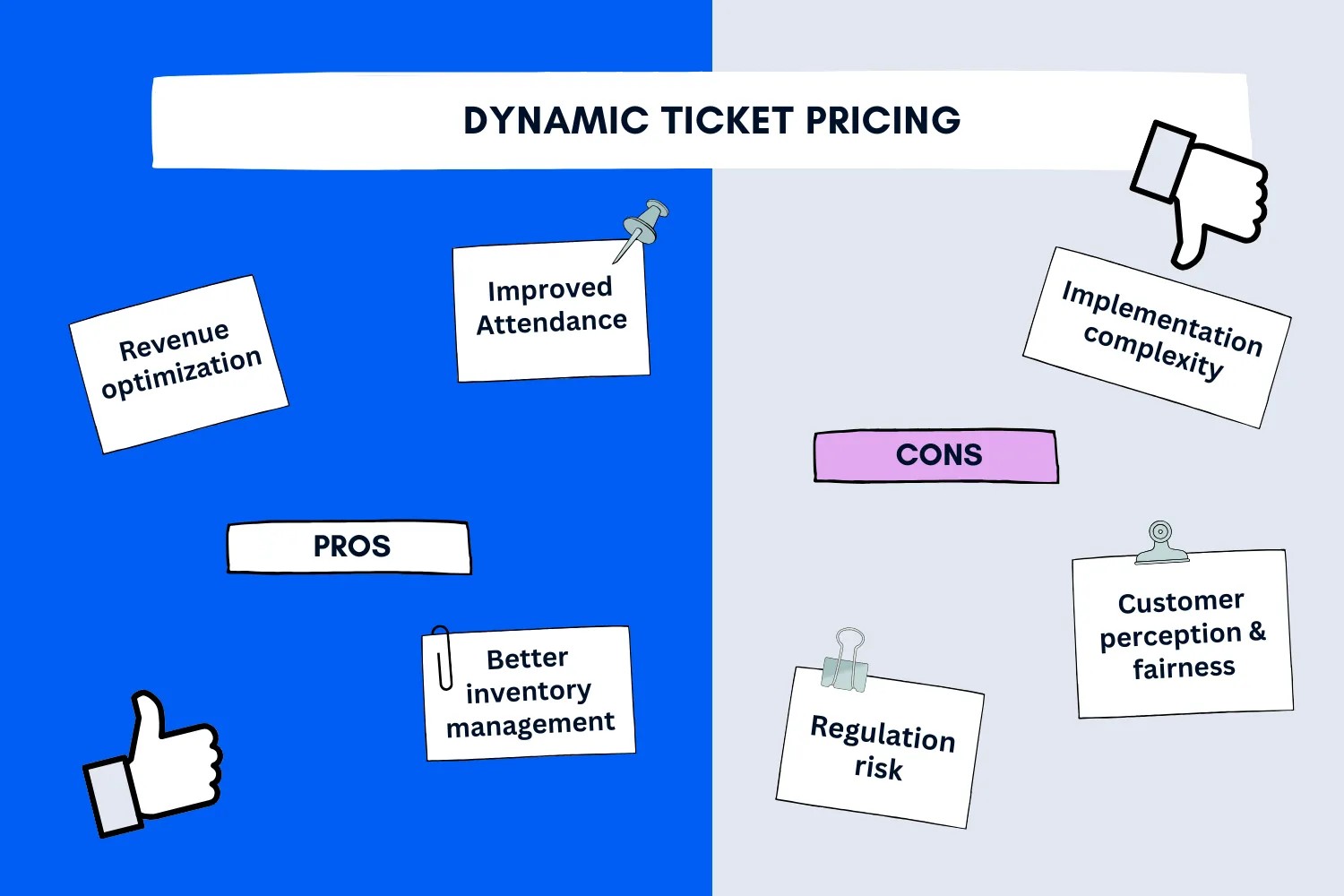
Dynamic ticket pricing—also called demand-based pricing—is the practice of adjusting ticket prices as demand, inventory, and market conditions change. Instead of setting a single static price, organizers let prices move within well-defined guardrails, responding to signals like how fast seats are selling, the day of the week, competitor events, weather, or the star power of an opponent or artist. It’s becoming standard across sports, concerts, theater, and festivals because tickets are perishable inventory: once the event starts, unsold seats are worth zero.
When it’s done well, dynamic ticket pricing can lift revenue and attendance simultaneously. When it’s done badly, it creates sticker shock, fan frustration, and headlines you don’t want. So the big question is simple:

The Loopyah Content Team shares expert insights, practical guides, and industry updates to help event organizers create unforgettable experiences and stay ahead in the event planning world.
marketing
In this guide, we’ll unpack the mechanics, benefits, and pitfalls—and lay out practical best practices that keep fans on your side while improving your yield.
If you’re just getting started with pricing strategy more broadly, you may also want to review our deeper dive on ticket pricing strategies to see how dynamic pricing complements seasonality, bundling, and tiered approaches.
Dynamic ticket pricing updates prices in near real time by reading demand and supply signals. A rules engine or machine learning model estimates how sensitive buyers are to price right now, then recommends small, frequent adjustments within your guardrails. This contrasts with fixed pricing (set once and never change) and simple tiered pricing (e.g., “early bird, general, late” time buckets), which are easier but leave money on the table when demand surges—or seats empty when demand softens.
Common factors that influence dynamic prices include:
Time to event: Lead time, day-of-week, and time-of-day effects.
Demand intensity: Traffic and conversion rates on your site, waitlist size, and add-to-cart velocity.
Event attributes: Opponent strength in sports, artist popularity and hype cycle in music, local competition, weather, and holidays.
Seat quality and scarcity: Section, row, view, and remaining inventory by price tier.
Market signals: Secondary market prices and availability; competitor events and pricing; promo calendar.
The big difference is responsiveness. With dynamic pricing, you react to real buying behavior and inventory decay—instead of guessing months in advance.
When demand spikes—say a rivalry game, a playoff push, or a viral TikTok about your festival—dynamic pricing helps you participate in that upside. Rather than selling out instantly at a static price (and leaving arbitrage to resellers), you can nudge price upward in small steps, monetize the surge, and keep more of the value you created.
This isn’t theoretical. An NHL franchise used an in‑house neural‑network model to automate adjustments during the 2023–24 season and reported six‑figure incremental single‑game ticket revenue—without sacrificing sell-through. The lesson: even modest-scope models can drive measurable gains when they’re embedded into day-to-day workflows with analyst oversight.
Dynamic pricing is not just about raising prices. It’s also a smart markdown system for off-peak inventory. When a section is lagging or a weekday show needs a push, your engine can apply targeted, temporary price reductions and pair them with offers to fence off the discount (e.g., members-only, student sections, family packs) without cheapening the entire house.
A recent women’s basketball pilot used automated, real-time price updates throughout the on-sale. Across hundreds of micro‑adjustments, the program sold hundreds more tickets than the static baseline and modeled a path toward double‑digit revenue growth at scale—all while improving the in‑venue atmosphere. The takeaway: tuned, real-time markdowns can lift both bodies in seats and overall yield.
If you’re optimizing the full funnel, remember that price is only one input to conversion. Pair your strategy with better creative, urgency, and frictionless checkout. For more on that, see our guide to factors affecting ticket sales conversion.
Tickets are perishable. Dynamic (and markdown) algorithms help you monetize late-stage inventory more effectively than last‑minute blanket discounts. With clear guardrails—think floors, ceilings, and maximum change frequency—you can steadily rebalance sections, avoid panic drops, and protect brand equity. Robust models will also learn how proximity to the event changes elasticity by section, so your late-stage strategy is precise, not blunt.
When fans see prices jump dramatically, they may interpret it as gouging. High-profile controversies in recent years show that visible volatility can create backlash, especially for passion brands. The cure is proactive communication, predictable rules, and visible value: explain how and why prices can move, reserve accessible price points (e.g., student/family sections), and avoid extreme spikes that feel punitive.
Aggressive pricing that surprises fans invites scrutiny. In the UK, dynamic pricing controversies have triggered watchdog investigations and commitments from major platforms to clarify pricing. In the U.S., the Federal Trade Commission’s Junk Fees Rule and California’s “Honest Pricing” law require all‑in, upfront pricing. Regardless of your dynamic rules, show the full price early and often, and make your policies easy to understand.
Transparency isn’t optional. Display the total price upfront and tell fans—in plain language—how and when ticket prices might change.
Dynamic pricing requires data pipelines, forecasting, and controls. You’ll need clean event metadata (artist/opp strength, seat attributes), real-time demand signals (traffic, conversion), and runtime guardrails (floors/ceilings, maximum change per interval). Automated systems can also behave in unexpected ways—e.g., inadvertently coordinating with other sellers or creating unfair disparities if unconstrained. That’s why governance matters: audit your models, monitor outcomes across segments, and keep humans in the loop to spot anomalies.
Messaging is part of the system too. Before you adjust prices, align your communications plan: announce your approach, explain fairness policies, and equip your support team with clear talking points. For help planning and sequencing those sends, see our guide to event email marketing strategy.
The winning playbook combines science (data and models) with strategy (guardrails, messaging, and governance). Use this checklist to implement dynamic ticket pricing that boosts revenue and keeps trust.
This is trivial, but worth reinforcing, use an existing platform that has dynamic pricing features with strict compliance measures. Doing this on your own, is probably a risk and a major cost to develop.
Set concrete goals and constraints. Decide how you’ll balance revenue, sell‑through, and fan satisfaction. Put explicit floors and ceilings in writing per section and persona (e.g., member/student).
Map the demand drivers for your events. Capture opponent/artist draw, day-of-week, local comps, and seat quality in your data model. These features power accurate estimates of price sensitivity.
Start with rules, graduate to models. Begin with simple heuristics (e.g., +$5 when conversion > X%) and evolve to supervised models that learn non‑linear effects over time.
Build guardrails that protect fans and your brand. Examples: limit changes to once every N minutes; cap per‑update increases; set event‑long and section‑level floors; keep reserved affordable inventory for community, students, or families.
Communicate transparently. Tell fans up front that prices may change as demand changes. Use all‑in pricing so buyers aren’t surprised at checkout.
Segment thoughtfully. Reward loyalty with early access or fixed-price windows. Offer targeted discounts to specific groups instead of globally dropping prices.
Run careful experiments. A/B test pricing rules, but account for interference (e.g., word-of-mouth and secondary market effects can leak between groups). Use covariate-adjusted estimators and adequate sample sizes before you roll out changes.
Instrument the full funnel. Track traffic, add-to-cart, conversion, and post-purchase sentiment by section/persona. Dynamic pricing is only as good as the telemetry you collect.
Create a command center. Centralize pricing ownership, alerts, and overrides so analysts can react fast to outliers (weather, lineup changes, injuries). Document a playbook for common scenarios.
Review fairness and compliance. Audit outcomes by demographic/segment where appropriate, and ensure your displays meet current transparency rules in your jurisdictions.
In the NHL, the Dallas Stars built an in‑house neural‑network model to automate adjustments. By integrating it directly into ticketing operations and setting sensible guardrails, the team reported more than $300,000 in incremental single‑game ticket revenue in 2023–24. Crucially, the system didn’t just surge prices; it rebalanced inventory by section, improving both yield and seat utilization.
A 2025 pilot for South Carolina women’s basketball integrated automated price updates with their ticketing system. Over the run, 300+ micro‑changes led to 759 additional tickets sold versus static pricing, with a modeled path to roughly 40% revenue growth at scale. The program’s key strengths were transparency, tight guardrails, and analyst oversight.
By contrast, high‑visibility run‑ups for certain marquee shows have drawn public ire and calls for restraint. Episodes like the Bruce Springsteen 2023 backlash and the UK Oasis reunion controversies underline the risk: large, fast swings—especially when buyers discover fees late—erode trust. The lesson isn’t “don’t use dynamic pricing.” It’s “use it with rules and clear, all‑in displays.”
Lessons learned:
Announce your approach and all‑in price displays ahead of high‑demand drops.
Set event‑specific caps for price movement and avoid last‑minute whiplash.
Hold accessible inventory and loyalty benefits to preserve perceived fairness.
Whether you build in‑house or buy, your dynamic pricing stack should combine demand forecasting, seat‑level elasticity, automated rules, and robust reporting. Many ticketing platforms now support pricing rules or integrate with optimization engines; some organizations also stitch together in‑house models with custom dashboards for analyst overrides.
Features to look for:
Data inputs: real-time traffic/conversion, seat map inventory, and event metadata (artist/opp draw, day-of-week).
Optimization: price recommendations by section/seat with explainability—why the price moved, and by how much.
Guardrails: configurable floors/ceilings, max change per interval, and event‑specific caps.
Automation: scheduled or trigger‑based updates; rollback and override controls for analysts; audit logs.
Market awareness: competitor and secondary-market signals to prevent mispricing and arbitrage.
Reporting: revenue lift attribution, sell‑through by segment, and fairness monitoring.
In adjacent industries like hospitality and short‑term rentals, platforms such as PriceLabs and Beyond Pricing popularized automated, demand‑driven price updates. While those tools are not event‑specific, their feature sets—explainable recommendations, guardrails, and multi‑channel sync—are a helpful blueprint for what to expect in event pricing systems.
Curious what a modern event stack can include beyond pricing? Explore our event software features to see how analytics, messaging, and seat maps can work together to support your pricing strategy.
Looking ahead, AI will make dynamic ticket pricing more predictive and more personalized. Models will better anticipate demand pockets by micro‑segment (e.g., families vs. superfans), and pricing will increasingly coordinate with merchandising, seat bundling, and even concessions to maximize overall experience value.
At the same time, regulators and fans are raising the bar on transparency. All‑in pricing is becoming table stakes in the U.S., and fairness expectations are rising globally. The organizations that win will design for both: AI‑enabled optimization held in check by explicit guardrails, clear messaging, and consistent value cues (benefits for members, students, and locals; reserved affordable sections; and predictable rules for high‑heat events).
Finally, expect more experimentation—but with better methods. Price tests can suffer from spillovers and secondary market interference. Savvy teams will adopt debiased experimentation techniques and use covariate‑adjusted estimators to isolate true effect sizes before scaling new pricing rules.
Dynamic, demand‑based ticket pricing can unlock meaningful revenue and attendance gains—but only when it’s run as a disciplined system. The best programs use real‑time data and automation, protect fans with clear guardrails and all‑in transparency, and keep analysts in the loop to steer edge cases. Do that, and you’ll capture more upside from high‑demand moments while building long‑term trust.
Ready to bring dynamic pricing into your playbook—without risking fan goodwill? Start with clear goals, simple rules, and transparent messaging, then iterate as your data matures.
Further reading and references:
We’d love to hear from you: What’s worked (or not) in your venue or series? Share your dynamic pricing experiences and lessons with the Loopyah community.

marketing









marketing
tools
tools
marketing
selling
marketing
selling
growth
planning